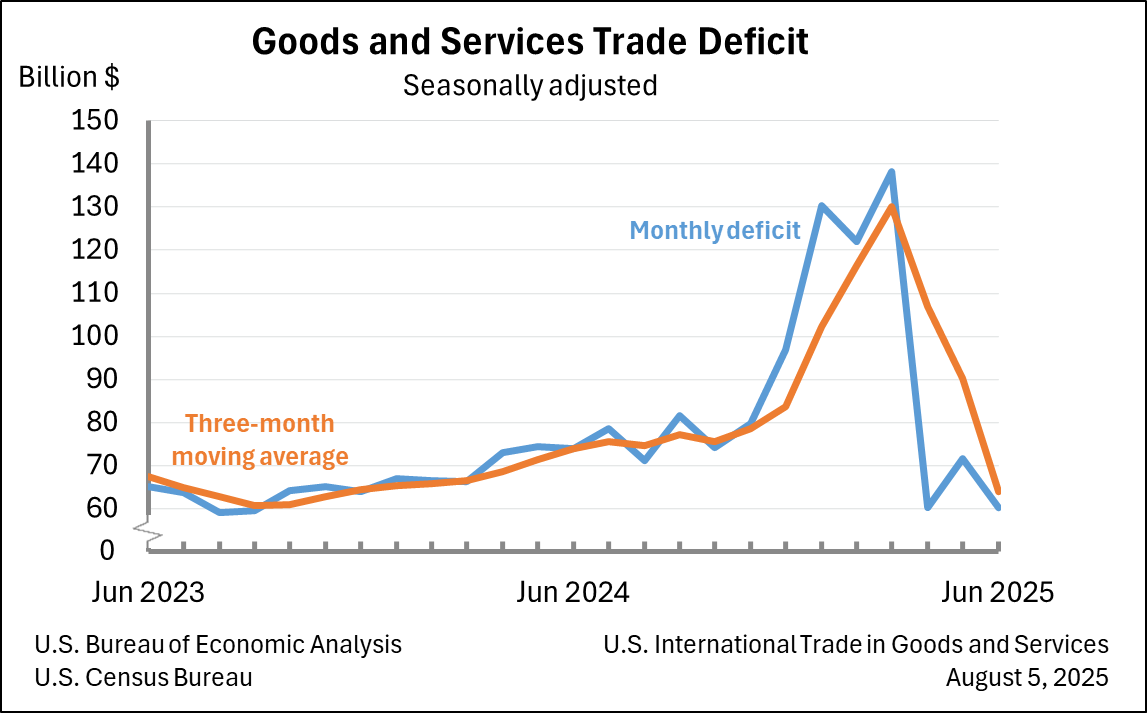Bureau of Economic Analysis
U.S. International Trade in Goods and Services, June 2025
The U.S. goods and services trade deficit decreased in June 2025 according to the U.S. Bureau of Economic Analysis and the U.S. Census Bureau. The deficit decreased from $71.7 billion in May (revised) to $60.2 billion in June, as exports decreased less than imports. The goods deficit decreased $11.4 billion in June to $85.9 billion. The services surplus increased $0.1 billion in June to $25.7 billion.
Principal Federal Economic Indicators
Noteworthy
- 2025 News Release Schedule
- Innovation at BEA
- 2025 Annual Updates
- New! Services Trade Data for More Countries
- Data Tool: Trade in Value Added
- Distribution of State Personal Income
- Updated: RIMS II Regional Multipliers
- Arts and Culture
- Space Economy
- FDI Now in State BEARFACTS
- Quick Guide: Price Indexes
The Latest
May 31st Deadline for Returning Completed Foreign Direct Investment Surveys Draws Near
The May 31st deadline is rapidly approaching for people to return their completed BE–12 surveys to the U.S. Bureau of Economic Analysis.
These surveys are critical to BEA’s ability to produce statistics on foreign direct investment in the United States. The statistics help policymakers and the general public understand the impact of foreign investment on the U.S. economy.
Therefore, it is vitally important that you waste no…
March 2013 Trade Gap is $38.8 Billion
The U.S. monthly international trade deficit decreased in March 2013 according to the U.S. Bureau of Economic Analysis and the U.S. Census Bureau. The deficit decreased from $43.6 billion (revised) in February to $38.8 billion in March as imports decreased more than exports. The previously published February deficit was $43.0 billion. The goods deficit decreased $4.6 billion from February to $56.1 billion in March; the services surplus…
Real Consumer Spending Increased in March
Personal income increased 0.2 percent in March after increasing 1.1 percent in February. Wages and salaries, the largest component of personal income, increased 0.2 percent in March after increasing 0.7 percent in February. Wages for services industries’ slowed, while wages for goods industries turned down slightly.
Current-dollar disposable personal income (DPI), after-tax income, increased 0.2 percent in March after…
Personal Income and Outlays, March 2013
Personal income increased $30.9 billion, or 0.2 percent, and disposable personal income (DPI) increased $20.7 billion, or 0.2 percent, in March, according to the Bureau of Economic Analysis. Personal consumption expenditures (PCE) increased $21.0 billion, or 0.2 percent. In February, personal income increased $151.2 billion, or 1.1 percent, DPI increased $134.0 billion, or 1.1 percent, and PCE increased $81.6 billion, or 0.7 percent, based on…
GDP Growth Picks Up in the First Quarter
Real gross domestic product (GDP) accelerated in the first quarter of 2013, increasing 2.5 percent after increasing 0.4 percent in the fourth quarter of 2012, according to estimates released by the Bureau of Economic Analysis.
Gross Domestic Product, 1st quarter 2013 (advance estimate)
Real gross domestic product -- the output of goods and services produced by labor and property located in the United States -- increased at an annual rate of 2.5 percent in the first quarter of 2013 (that is, from the fourth quarter to the first quarter), according to the "advance" estimate released by the Bureau of Economic Analysis.
Durable-Goods Manufacturing Led Growth in 2012
Durable-goods manufacturing, finance and insurance, and wholesale trade services were the leading contributors to U.S. economic growth in 2012, according to advance statistics on the breakout of real gross domestic product (GDP) by industry from the Bureau of Economic Analysis.
Advance Gross Domestic Product by Industry, 2012
Durable-goods manufacturing, finance and insurance, and wholesale trade were the leading contributors to U.S. economic growth in 2012, according to advance statistics on the breakout of real gross domestic product (GDP) by industry from the Bureau of Economic Analysis. Overall, 19 of 22 industry groups contributed to the 2.2 percent increase in real GDP.
Summary Estimates for Multinational Companies, 2011
The following are 2011 advance and 2010 revised summary estimates of the employment, capital expenditures, and sales activity of U.S. multinational companies (comprising both their U.S. and foreign operations) and the corresponding activity of foreign multinational companies in the United States. Preliminary 2011 and revised 2010 statistics based on more complete source data and including country and industry detail will be released…




